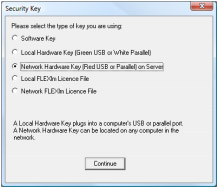PTW Installation Instructions
LAN (Red) Hardware Key by Aladdin
Contents
Overview Information
- System Requirements
- What is the Hardware Key?
- How Can I Tell what Operating System I Have?
- Should I Install PTW on the Server or on the Workstations?
- Part 1: Getting the server to broadcast the hardware key
- Part 2: Getting the server to see the hardware key
- Part 3: Getting the workstations to see the hardware key
- Part 4: (optional) Display license managers available and list of users
- What if I Want to Use the Key Temporarily as a Local Key?
System Requirements
Following is a list of the minimum system requirements for running PTW:
- Windows 2000, 2003, XP, and Vista
- Pentium III 600Mhz or better;
- 4 GB hard disk space;
- 512 MB of RAM (1 GB or more recommended for large projects);
- CD-ROM drive
- Printer or plotter recommended.
What is the Hardware Key?

The hardware key protects your investment and ours, and allows multiple people to use the software without violating the license agreement. Your PTW software will include one of these keys, and will not run without it. However, once you have installed the key, you can forget about it the key does its job automatically.
How can I tell what operating system I have?
Right-click on your "My Computer" icon and select Properties. The information about your operating system can be seen in the message box.
Should I Install PTW on the Server or the Workstations?
You have two options for installing and running PTW on a network:
- Install PTW on each workstation (preferable if you want each user to have his or her own set of Libraries);
(or) - Install PTW on a dedicated or non-dedicated file server and run PTW on each workstation using a shortcut to that file server (preferable if you want everyone to use the same set of Libraries). If you use option 2, you will need to install the font files used to every workstation (the font files are used by the load schedule reports, Crystal Reports and the on-line Reference Manual.) To install the font files to every workstation, insert the PTW CD in the workstation's CD-ROM drive. The following screen will appear automatically.
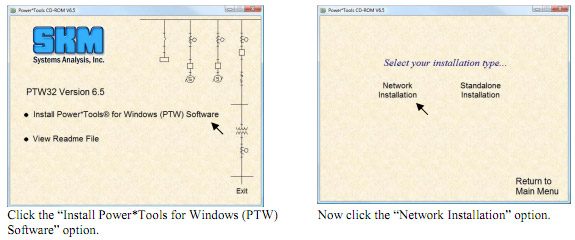
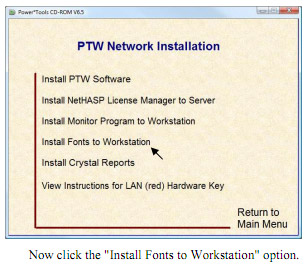
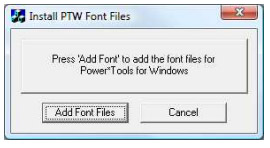
Additional files are needed to be register to use the Crystal reports in PTW. To install the Crystal reports. To install these Crystal Report files use the run command line and type \PTW32\BIN\CR_SETUP.EXE. The Crystal Report installation program will start
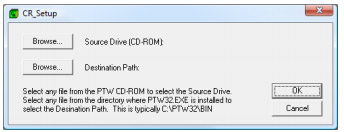
Use the browse buttons to specify the location of the PTW32 program CD; then use the second browse button to specify the install location for PTW32.
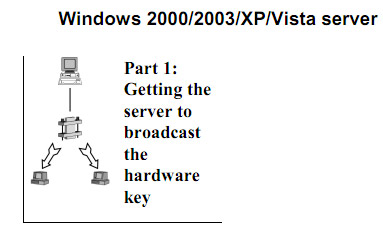
- Attach the hardware key to the server. (You may attach the hardware key to a workstation instead of the server, but you must keep that workstation turned on anytime another workstation wants to use PTW. Since users typically turn off their workstations when they leave work, we recommend that you put the hardware key on the server, since servers usually remain on at all times. Whichever you choose, though, remember that the computer with the hardware key must be turned on and the NetHASP License Manager must be broadcasting for PTW to run.)
- Log on with Full Administrative Rights, then insert the PTW CD-ROM.
- Click the "Install Power*Tools for Windows (PTW) Software" option.
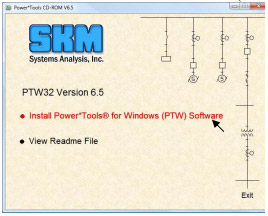
- Now click the "Network Installation" option.
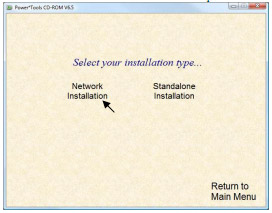
- Click the Install NetHASP License Manager to Server option.
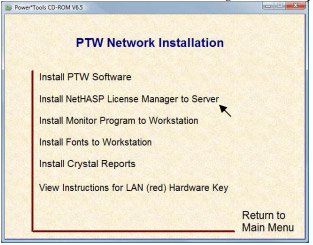
By selecting this option button, you are actually running LMSETUP.EXE, a program which installs the license manager program, and device driver that allows Windows to see the hardware key. You should see a window similar to the following.
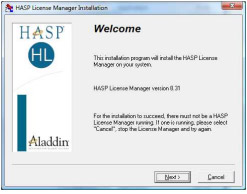
- Click "Next" to continue with the installation for the NetHASP License Manager & device driver. You will then be prompted to install the license manager as a service or as an application. Select the option you want and click the "Next" button.
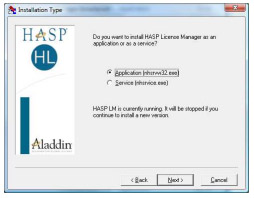
Next, select the install location for the license manager files. The picture below shows the default directory
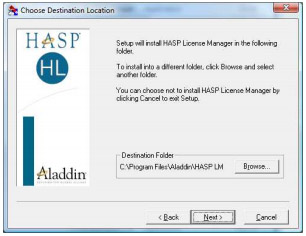
You will then be prompted to link the Hasp Lincense Manager to start up folder or not. Select the option you wish and click on the "Next" Button.
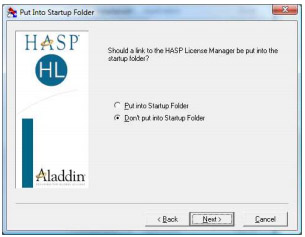
The installation program then creates a program group for the License Manager program. Just click on the "Next" button.
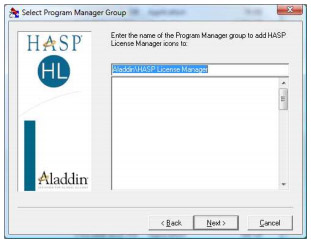
The License Manager finishes installation and will show a similar window below. It will then prompt you if you want to install the Hasp Device Driver as well. If you select "Yes", continue with step 2
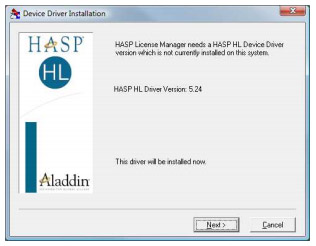
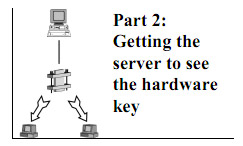
When the License Manager finishes installation, the setup program provides an option to install the Hardware key device drivers needed by the computer to recognize the hardware key. Once you clicked on the "Yes" button above you will see a similar picture below.

The screen similar to the one below is displayed upon completion of the installation for the Hasp Device Driver. Just click on "Yes" if you wish to run the Hasp License Manager Now.
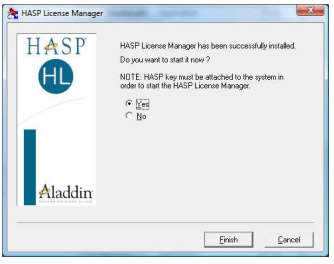
The installation program finishes and starts up the NetHASP license manager�

The NetHASP License Manger appears minimize next to the clock
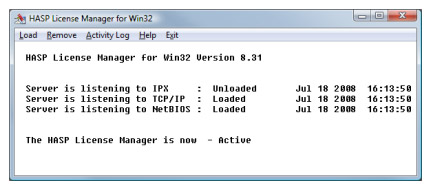
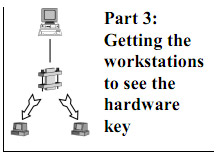
If your workstations will run PTW using a shortcut to the dedicated or non-dedicated file server, you only need to perform the following steps on the computer with the hardware key. If your workstations will have PTW installed and run locally, you need to repeat these steps on each workstation which has PTW installed.
For networks using TCP/IP protocol
- Go to the \PTW32\BIN folder and look for the NETHASP.INI file.
- Open the NETHASP.INI file and find the [NH_COMMON] Section. (Since NETHASP.INI is a text file, open it in a text editor. Notepad, which comes with Windows, works best because it does not insert extra characters into the file.)
- Be sure to ONLY un-remark the line indicated. All other lines should still have semicolons in front of them. Un-remark (that is, delete the two semicolons in front of) the line
;;NH_TCPIP = Enabled
so that the line reads:
NH_TCPIP = Enabled - Find the [NH_TCPIP] Section.
- Un-remark the line
;;NH_SERVER_ADDR=<IP Addr1>
and enter the dedicated server or non-dedicated server IP (internet protocol) address of the computer where the
red hardware key is attached and from where the NetHASP License Manager broadcasts in place of the text
<IP Addr1>
For example, if the IP address is 198.0.0.130, you would retype the line like this:
NH_SERVER_ADDR=198.0.0.130 - While in the [NH_TCPIP] Section, un-remark the line
;;NH_USE_BROADCAST = Disabled
so that the line reads: NH_USE_BROADCAST = Disabled - Save the NETHASP.INI file.
- Test whether PTW will run on the workstation. If it does not, check the NETHASP.INI file to ensure that only the line indicated has the semicolons removed, and that all the other lines still have semicolons in front of them. If you receive an Error Code 8, open the NETHASP.INI file and, in the [NH_TCPIP] Section, un-remark the line
;;NH_TCPIP_METHOD = UDP
so that the line reads:
NH_TCPIP_METHOD = UDP - Save the NETHASP.INI file and try running PTW again.
Monitoring the Hardware Key & Users
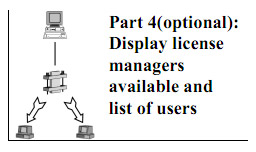
The monitor program enables you to see the list of License managers available on your network. It also displays the list of user login to the hardware key.
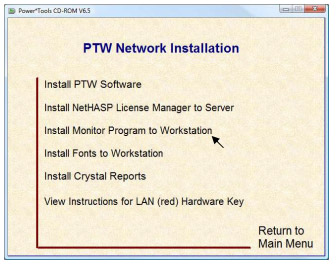
To install the monitor program select "Install Monitor Program to Workstation" . The following screen will then show up.
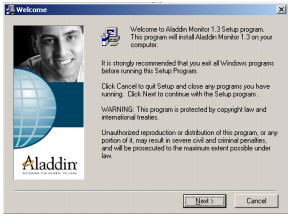
Click "Next" button to continue
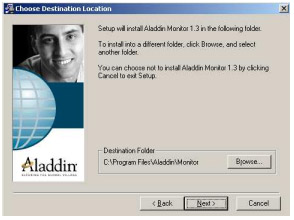
The setup program displays the default installation directory as shown above, to continue click on the computer/box button. Click on the "Next" button and the monitor program will start installing.
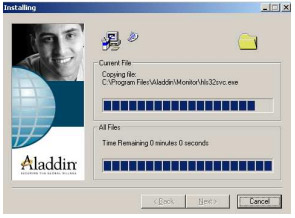
Once done monitor program finished installation, it will show the following message. Click on the "Finished" button.
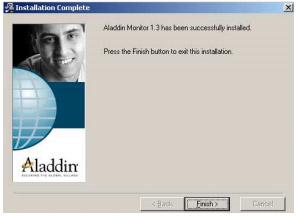
Use the Monitor program to check if your workstation has access to the hardware key.
- Open the AKS Monitor program

- The Monitor Window appears:
The Monitor program displays the selected License Manager information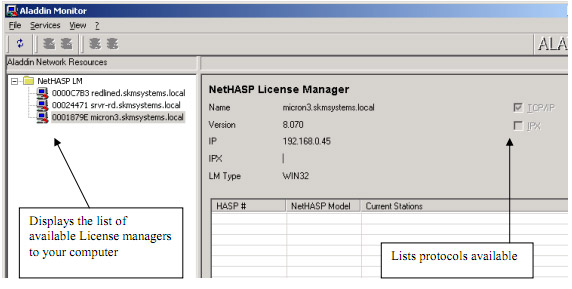
- The monitor program displays the list of users accessing the network HASP hardware key.
The following table contains the program number along with the corresponding study module.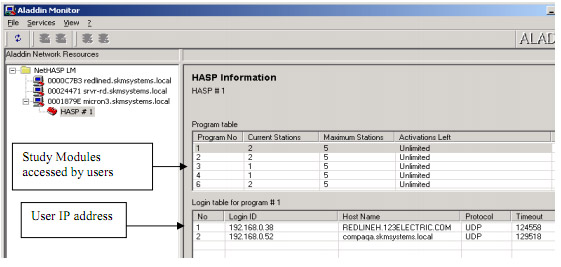
PROGRAM NO. Module Name 3 TPW//BASE FUNCTIONALITY 4 PTW_DAPPER // damand load sizing, load flow, short circuit 5 PTW_TMS 6 PTW_AFAULT 7 PTW_IEC_FAULT 8 PTW_CAPTOR 9 PTW_HIWAVE 10 PTW_ISIM 11 PTW_DEVEVAL 12 PTW_UNBALANCED 13 PTW_RELIABILITY 14 PTW_GRNDMAT 15 PTW_ARC_FLASH 16 PTW_IEC61363 17 PTW_BATTERY 18 PTW_DC_LF 19 PTW_DC_SC 20 PTW_CABLE3D 21 PTW_DMSLF 22 PTW_CALC 13 PTW_WIRING
What if I Want to Use the Network Key Temporarily as a Local Key?
Occasionally you might want to use the network hardware key locally-for example, if you have a laptop computer and want to take the key home. You can install PTW on the computer as you normally would, but once PTW is installed you will need to install the standalone driver for the hardware key.
- To do so, after you have installed PTW on the computer, click the Key Utility program in the Power*Tools group. The following dialog box will appear:
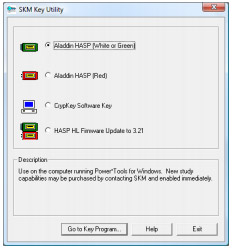
- Select Aladdin MemoHASP (White or Green) and click the Go to Key Program button. (Even though the icon shows a white key or green USB key, you need to choose this option so the standalone driver will be installed.)
- Click the OK button and select to install the driver
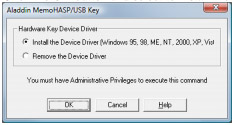
- When the drivers are finished, you will need to install and activate the License Manager. Refer to page 5 for complete instructions.
- Configure C:\PTW32\bin\nethasp.ini. If you are connected to a DHCP server, you can use the IP address of your local machine. Otherwise, configure your Computer Host Name as the server address. Refer to page 10 for complete instructions.
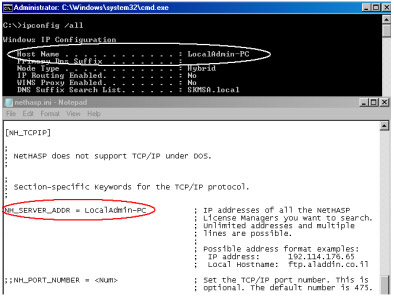
- Start PTW32 and when prompted, select "Network Hardware Key".
